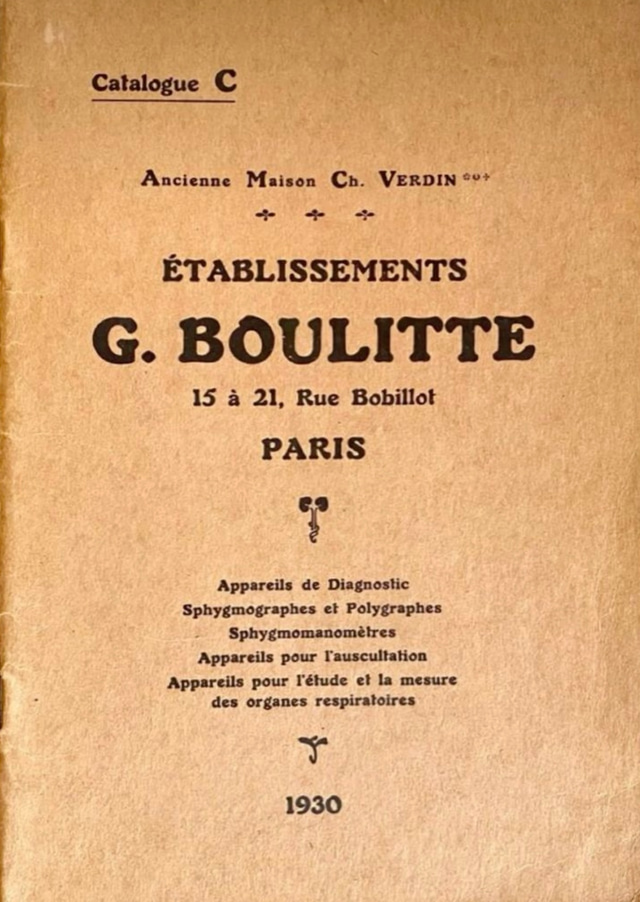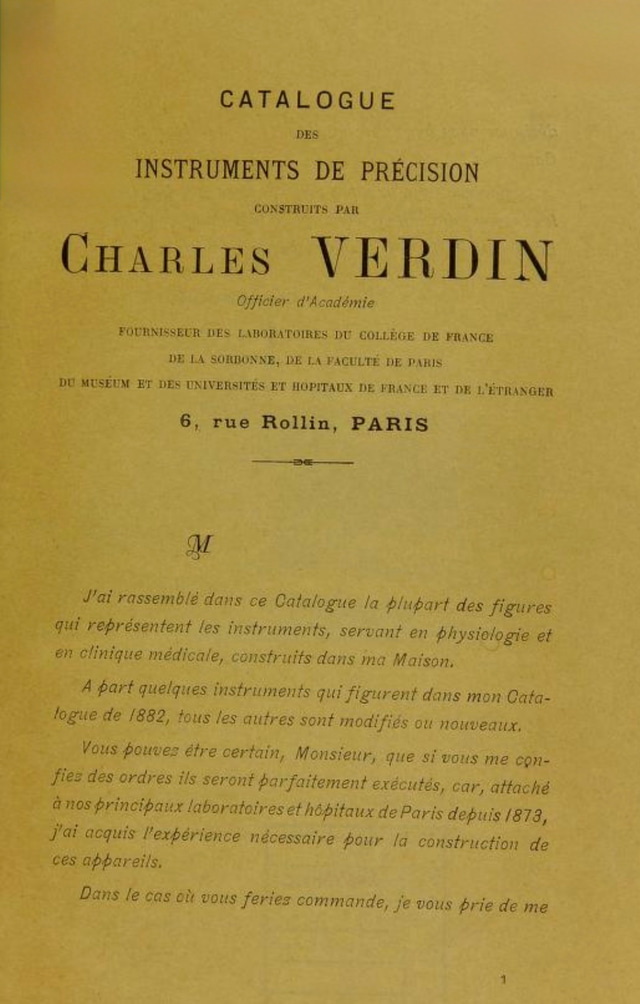

History of the G. Boulitte Company: From Charles Verdin to Georges-Charles Boulitte
The Charles Verdin Firm (Foundation and Activity)
Charles Verdin was a Parisian scientific instrument tuner and craftsman active in the mid-19th century. His enterprise specialized in precision measuring instruments and medical-physiological devices of the era. In particular, under Verdin’s management, the firm produced mechanical manometers, barometers, and instruments for physiological research (such as early sphygmographs for recording pulse and blood pressure). Verdin’s products were in demand in scientific laboratories and the medical field, earning the company a reputation as a reliable manufacturer of precision instruments. By the late 19th century, Charles Verdin ceased operations (either through retirement or death), and his well-established business needed a successor to carry on its legacy.
Transition to Georges-Charles Boulitte (Succession)
The successor was engineer Georges-Charles Boulitte, a specialist in instrument construction. In the late 1880s (at the turn of the 19th–20th centuries), he assumed leadership of Verdin’s firm, inheriting both its production facilities and client base. Later instruments manufactured by Boulitte explicitly stated that the enterprise was the “ancienne maison Ch. Verdin” (“former house of Charles Verdin”), thus maintaining the continuity of the firm’s traditions and reputation. Georges-Charles Boulitte himself was an engineer and instrument maker, as reflected in the company’s plaques marked “ingénieur constructeur.” This indicated that the new owner had a technical education and personally participated in the design of instruments. The business transition appears to have been smooth; Boulitte likely worked with Verdin before taking over the operation under his own name.
Development of G. Boulitte Company in the Early 20th Century
Under Georges-Charles Boulitte’s leadership, the company not only continued traditional activities (manufacture of precision measuring devices) but also significantly expanded its portfolio in line with the scientific advances of the early 20th century. Range of Instruments: Boulitte produced the classic instruments inherited from Verdin — manometers, barometers, vacuum gauges, laboratory equipment — and refined them. For example, the company manufactured sphygmomanometers for measuring blood pressure; notably, early models from the early 20th century were calibrated in centimeters of mercury (whereas millimeters would later become the standard).
At the same time, G. Boulitte actively developed new instruments for medical diagnostics. By the early 1900s, the firm had mastered the production of equipment for clinical physiology and cardiology. Catalogs from the early 20th century mention “appareils pour l’électrocardiographie” — systems for electrocardiography. Boulitte was one of the first in France to construct a full set of equipment based on Willem Einthoven’s method, including the famous string galvanometer electrocardiograph.
Descriptions of the device (circa 1912) noted that Professor Einthoven’s method, introduced into clinical practice, required a complete suite of apparatus: a powerful electromagnetic string galvanometer and a photographic recorder. The G. Boulitte company developed these components and combined them into a unified device that could record the heart’s electrical activity onto photographic film.
In parallel, classical instruments were continuously improved. For instance, G. Boulitte’s manometers and pressure sensors were used not only in medicine but also in industrial applications and scientific experiments — wherever precise pressure or vacuum measurement was required. Thus, under Boulitte, the company expanded its fields of application: its instruments served hospitals and clinics (cardiology, therapy), physiological institutes, university laboratories, and various engineering projects.
Key Stages and Achievements of G. Boulitte
Addresses and Expansion: Initially, the firm was located in the center of Paris. The office and workshops were based at 7, rue Linné, Paris — near the Latin Quarter and major scientific institutions. However, as the company grew, Boulitte relocated production to a more spacious site. Plaques from the 1910s show the new address: “15–21, rue Bobillot, Paris.” This indicates that the factory occupied multiple buildings, reflecting the company’s expanded operations and the need for facilities to house complex equipment (such as electrical and photographic apparatus for ECG recording).
Participation in Scientific Projects: A distinctive feature of the company’s growth was its close ties to cutting-edge scientific research. Georges-Charles Boulitte personally collaborated with prominent scientists of the time. Notably, in the development of electrocardiographs, he worked with Lucien Bull — engineer and deputy director of the Marey Institute (the laboratory of physiologist Étienne-Jules Marey).
Bull, with his expertise in high-speed cinematography of physiological processes, advised Boulitte on improving ECG apparatus design. In a 1922 publication, Boulitte expressed his gratitude to “Mr. L. Bull, Deputy Director of the Marey Institute, for his valuable advice and high expertise in perfecting our electrocardiograph.” This indicates that the company had been engaged in the development of electrocardiographic devices for at least fifteen years (since around 1907) and had introduced an improved model to the market by the early 1920s. Thus, G. Boulitte stood at the forefront of practical electrocardiography in France, bringing the latest scientific breakthroughs into medical technology.
Applications of Products:
While Verdin’s era focused primarily on mechanical precision for scientific instruments, under Boulitte the company’s profile broadened considerably. G. Boulitte began producing electromechanical and optical systems while maintaining the high quality of classical instruments. The company’s devices were widely used in clinical medicine (diagnosis of cardiovascular diseases, measurement of human physiological parameters) and in physiological experiments.
For instance, Boulitte’s string galvanometer-based electrocardiographs enabled cardiologists and researchers to record ECGs, something previously available only in major university laboratories. At the same time, G. Boulitte’s manometers and pressure sensors were used for monitoring blood pressure in therapeutic practice and could also be applied in technical fields (such as pump installations and studies of gases and vacuums). Thus, after succession, the company evolved from purely mechanical instruments of Verdin’s time to complex electrophysiological systems in Boulitte’s era. Nevertheless, continuity was preserved — new devices were developed based on the firm’s accumulated expertise in precision instrument making.
Later Years and Legacy
The G. Boulitte company remained active at least until the late 1920s–early 1930s. Documents from the interwar period (such as G. Boulitte’s 1922 electrocardiography manual) show that the firm continued to modernize its products and embrace new technologies.
Later, it is likely that Établissements G. Boulitte (the company’s official name) was either absorbed by a larger electrotechnical firm or gradually ceased operations by the mid-20th century (exact details for this period remain scarce).
Nevertheless, G. Boulitte’s contribution to the history of instrument making remains significant: many of its instruments have survived in museum collections. On some artifacts, one can still see the inscription: “Ancienne Maison Ch. Verdin – G. Boulitte, Ingénieur-Constructeur, Paris,” reminding us of the continuity between two generations of craftsmen.
G. Boulitte carved its name into history, successfully bridging the Victorian-era scientific mechanics of the 19th century with the electromechanical innovations of the 20th century, thereby uniting two epochs of technological development.